Smart Cities: Potential and Implications of Smart Practices
VerifiedAdded on 2020/04/29
|11
|3637
|67
Essay
AI Summary
This essay delves into the multifaceted concept of smart cities, defining them as urban areas that leverage technology, particularly ICT, to optimize resource management and enhance citizen services. It explores the sustainable potential of smart practices, highlighting the role of technology in addressing urban challenges like population growth and environmental concerns. The essay discusses the integration of various technologies, including sensors, data analytics, and communication networks, to improve transportation, public health, and government operations. It examines the planning implications of these technologies, focusing on the development of sustainable policies and the convergence of technology with economics to create new models of urban living. Furthermore, the essay addresses the challenges associated with implementing smart city initiatives, such as sensory overload, financial constraints, and the digital divide, while also suggesting potential solutions and emphasizing the importance of citizen participation and government regulations. The essay also explores real-life examples of smart cities around the world and discusses various technologies used to transform a city into a smart city.

Running head: SMART CITIES 0
Urban Sustainable Region’s
Urban Sustainable Region’s
Paraphrase This Document
Need a fresh take? Get an instant paraphrase of this document with our AI Paraphraser
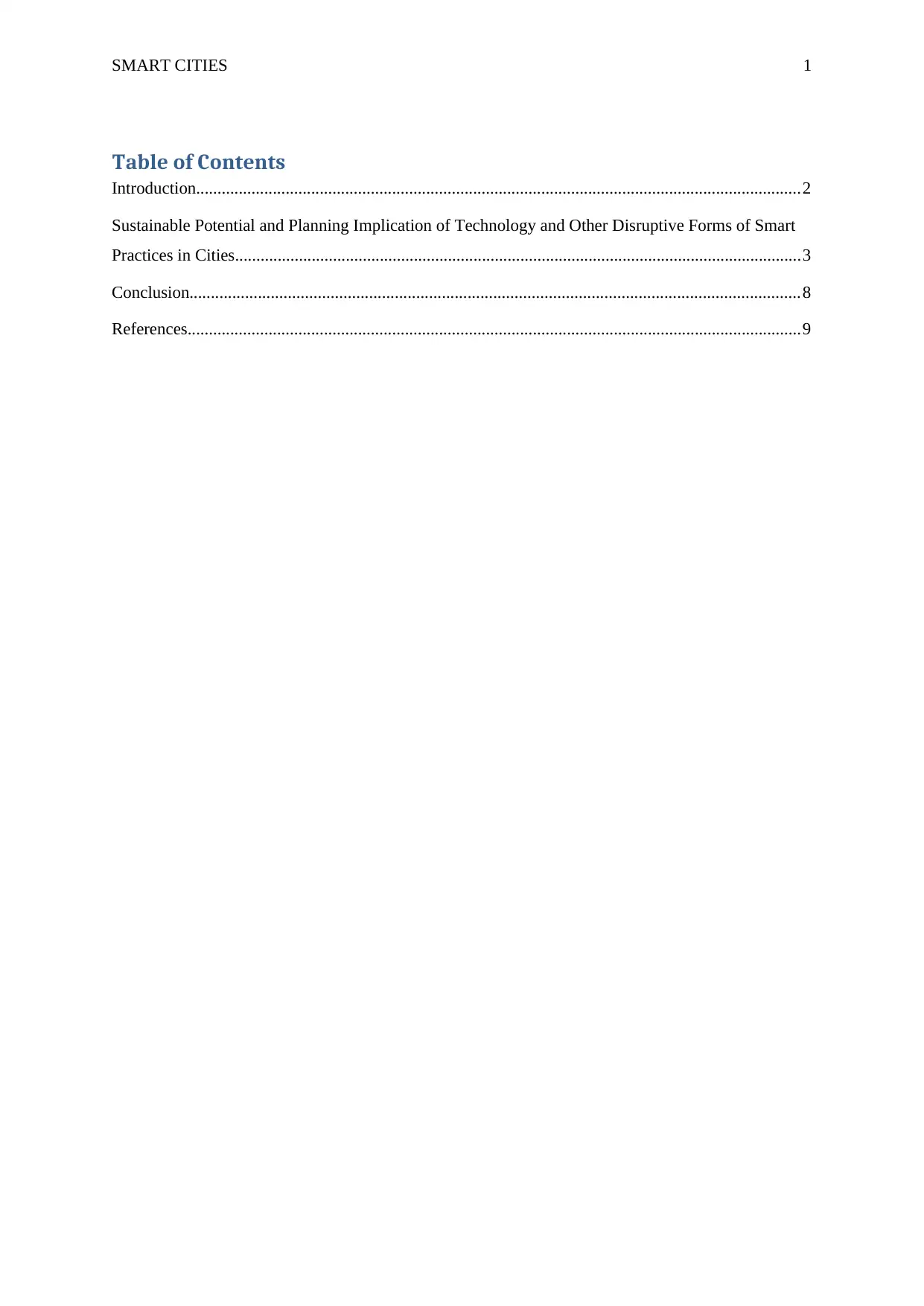
SMART CITIES 1
Table of Contents
Introduction..............................................................................................................................................2
Sustainable Potential and Planning Implication of Technology and Other Disruptive Forms of Smart
Practices in Cities.....................................................................................................................................3
Conclusion...............................................................................................................................................8
References................................................................................................................................................9
Table of Contents
Introduction..............................................................................................................................................2
Sustainable Potential and Planning Implication of Technology and Other Disruptive Forms of Smart
Practices in Cities.....................................................................................................................................3
Conclusion...............................................................................................................................................8
References................................................................................................................................................9
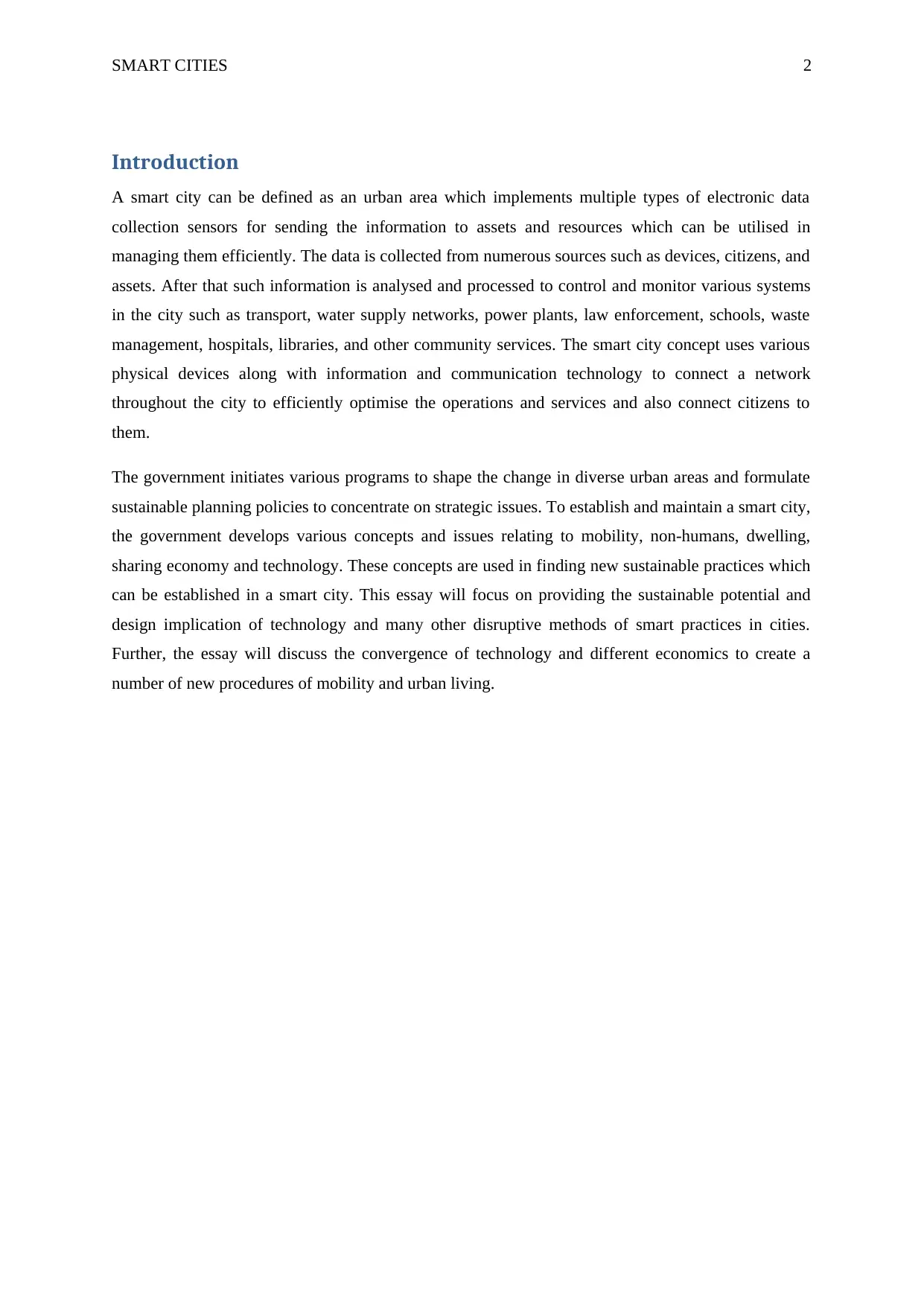
SMART CITIES 2
Introduction
A smart city can be defined as an urban area which implements multiple types of electronic data
collection sensors for sending the information to assets and resources which can be utilised in
managing them efficiently. The data is collected from numerous sources such as devices, citizens, and
assets. After that such information is analysed and processed to control and monitor various systems
in the city such as transport, water supply networks, power plants, law enforcement, schools, waste
management, hospitals, libraries, and other community services. The smart city concept uses various
physical devices along with information and communication technology to connect a network
throughout the city to efficiently optimise the operations and services and also connect citizens to
them.
The government initiates various programs to shape the change in diverse urban areas and formulate
sustainable planning policies to concentrate on strategic issues. To establish and maintain a smart city,
the government develops various concepts and issues relating to mobility, non-humans, dwelling,
sharing economy and technology. These concepts are used in finding new sustainable practices which
can be established in a smart city. This essay will focus on providing the sustainable potential and
design implication of technology and many other disruptive methods of smart practices in cities.
Further, the essay will discuss the convergence of technology and different economics to create a
number of new procedures of mobility and urban living.
Introduction
A smart city can be defined as an urban area which implements multiple types of electronic data
collection sensors for sending the information to assets and resources which can be utilised in
managing them efficiently. The data is collected from numerous sources such as devices, citizens, and
assets. After that such information is analysed and processed to control and monitor various systems
in the city such as transport, water supply networks, power plants, law enforcement, schools, waste
management, hospitals, libraries, and other community services. The smart city concept uses various
physical devices along with information and communication technology to connect a network
throughout the city to efficiently optimise the operations and services and also connect citizens to
them.
The government initiates various programs to shape the change in diverse urban areas and formulate
sustainable planning policies to concentrate on strategic issues. To establish and maintain a smart city,
the government develops various concepts and issues relating to mobility, non-humans, dwelling,
sharing economy and technology. These concepts are used in finding new sustainable practices which
can be established in a smart city. This essay will focus on providing the sustainable potential and
design implication of technology and many other disruptive methods of smart practices in cities.
Further, the essay will discuss the convergence of technology and different economics to create a
number of new procedures of mobility and urban living.
⊘ This is a preview!⊘
Do you want full access?
Subscribe today to unlock all pages.

Trusted by 1+ million students worldwide
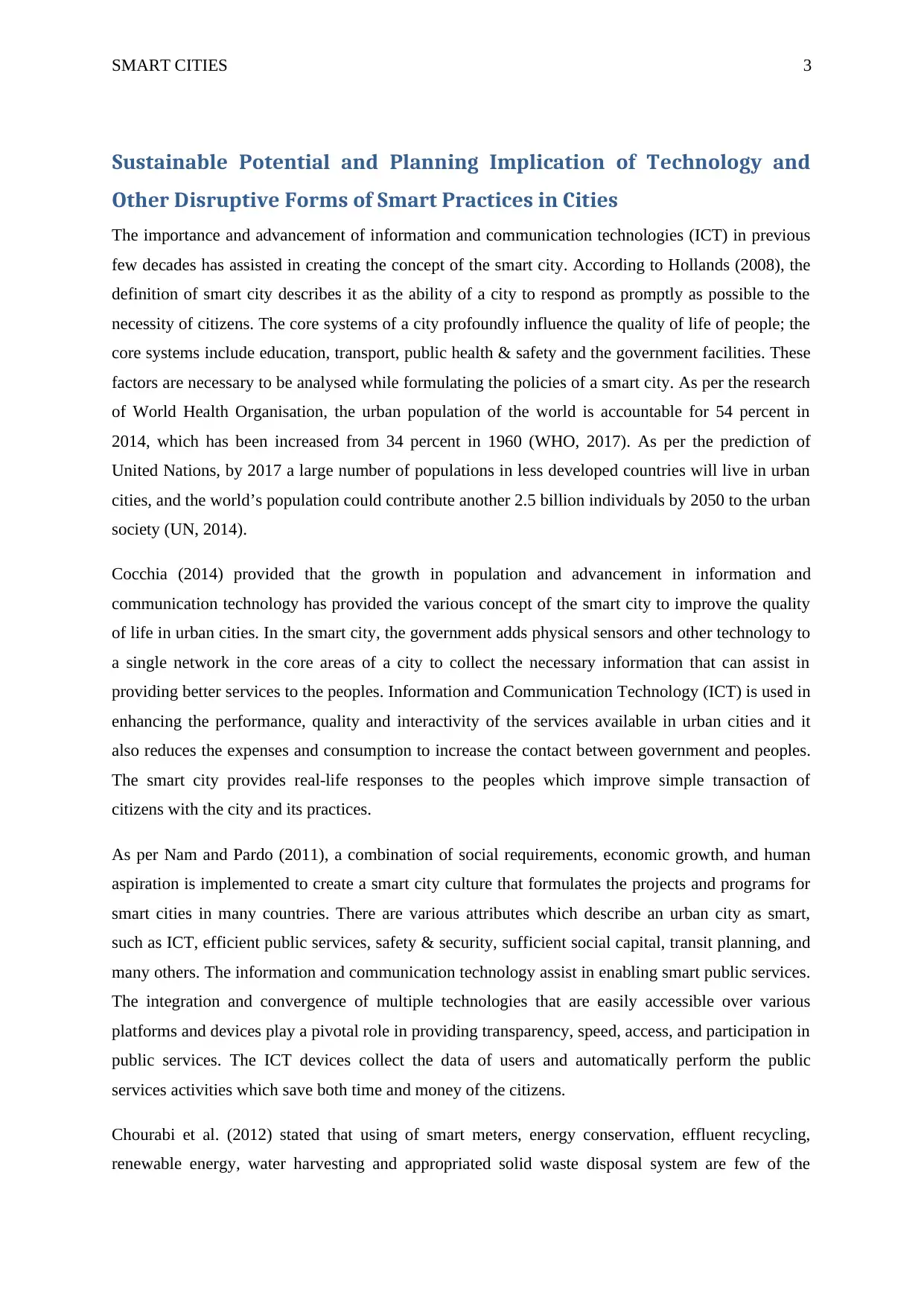
SMART CITIES 3
Sustainable Potential and Planning Implication of Technology and
Other Disruptive Forms of Smart Practices in Cities
The importance and advancement of information and communication technologies (ICT) in previous
few decades has assisted in creating the concept of the smart city. According to Hollands (2008), the
definition of smart city describes it as the ability of a city to respond as promptly as possible to the
necessity of citizens. The core systems of a city profoundly influence the quality of life of people; the
core systems include education, transport, public health & safety and the government facilities. These
factors are necessary to be analysed while formulating the policies of a smart city. As per the research
of World Health Organisation, the urban population of the world is accountable for 54 percent in
2014, which has been increased from 34 percent in 1960 (WHO, 2017). As per the prediction of
United Nations, by 2017 a large number of populations in less developed countries will live in urban
cities, and the world’s population could contribute another 2.5 billion individuals by 2050 to the urban
society (UN, 2014).
Cocchia (2014) provided that the growth in population and advancement in information and
communication technology has provided the various concept of the smart city to improve the quality
of life in urban cities. In the smart city, the government adds physical sensors and other technology to
a single network in the core areas of a city to collect the necessary information that can assist in
providing better services to the peoples. Information and Communication Technology (ICT) is used in
enhancing the performance, quality and interactivity of the services available in urban cities and it
also reduces the expenses and consumption to increase the contact between government and peoples.
The smart city provides real-life responses to the peoples which improve simple transaction of
citizens with the city and its practices.
As per Nam and Pardo (2011), a combination of social requirements, economic growth, and human
aspiration is implemented to create a smart city culture that formulates the projects and programs for
smart cities in many countries. There are various attributes which describe an urban city as smart,
such as ICT, efficient public services, safety & security, sufficient social capital, transit planning, and
many others. The information and communication technology assist in enabling smart public services.
The integration and convergence of multiple technologies that are easily accessible over various
platforms and devices play a pivotal role in providing transparency, speed, access, and participation in
public services. The ICT devices collect the data of users and automatically perform the public
services activities which save both time and money of the citizens.
Chourabi et al. (2012) stated that using of smart meters, energy conservation, effluent recycling,
renewable energy, water harvesting and appropriated solid waste disposal system are few of the
Sustainable Potential and Planning Implication of Technology and
Other Disruptive Forms of Smart Practices in Cities
The importance and advancement of information and communication technologies (ICT) in previous
few decades has assisted in creating the concept of the smart city. According to Hollands (2008), the
definition of smart city describes it as the ability of a city to respond as promptly as possible to the
necessity of citizens. The core systems of a city profoundly influence the quality of life of people; the
core systems include education, transport, public health & safety and the government facilities. These
factors are necessary to be analysed while formulating the policies of a smart city. As per the research
of World Health Organisation, the urban population of the world is accountable for 54 percent in
2014, which has been increased from 34 percent in 1960 (WHO, 2017). As per the prediction of
United Nations, by 2017 a large number of populations in less developed countries will live in urban
cities, and the world’s population could contribute another 2.5 billion individuals by 2050 to the urban
society (UN, 2014).
Cocchia (2014) provided that the growth in population and advancement in information and
communication technology has provided the various concept of the smart city to improve the quality
of life in urban cities. In the smart city, the government adds physical sensors and other technology to
a single network in the core areas of a city to collect the necessary information that can assist in
providing better services to the peoples. Information and Communication Technology (ICT) is used in
enhancing the performance, quality and interactivity of the services available in urban cities and it
also reduces the expenses and consumption to increase the contact between government and peoples.
The smart city provides real-life responses to the peoples which improve simple transaction of
citizens with the city and its practices.
As per Nam and Pardo (2011), a combination of social requirements, economic growth, and human
aspiration is implemented to create a smart city culture that formulates the projects and programs for
smart cities in many countries. There are various attributes which describe an urban city as smart,
such as ICT, efficient public services, safety & security, sufficient social capital, transit planning, and
many others. The information and communication technology assist in enabling smart public services.
The integration and convergence of multiple technologies that are easily accessible over various
platforms and devices play a pivotal role in providing transparency, speed, access, and participation in
public services. The ICT devices collect the data of users and automatically perform the public
services activities which save both time and money of the citizens.
Chourabi et al. (2012) stated that using of smart meters, energy conservation, effluent recycling,
renewable energy, water harvesting and appropriated solid waste disposal system are few of the
Paraphrase This Document
Need a fresh take? Get an instant paraphrase of this document with our AI Paraphraser
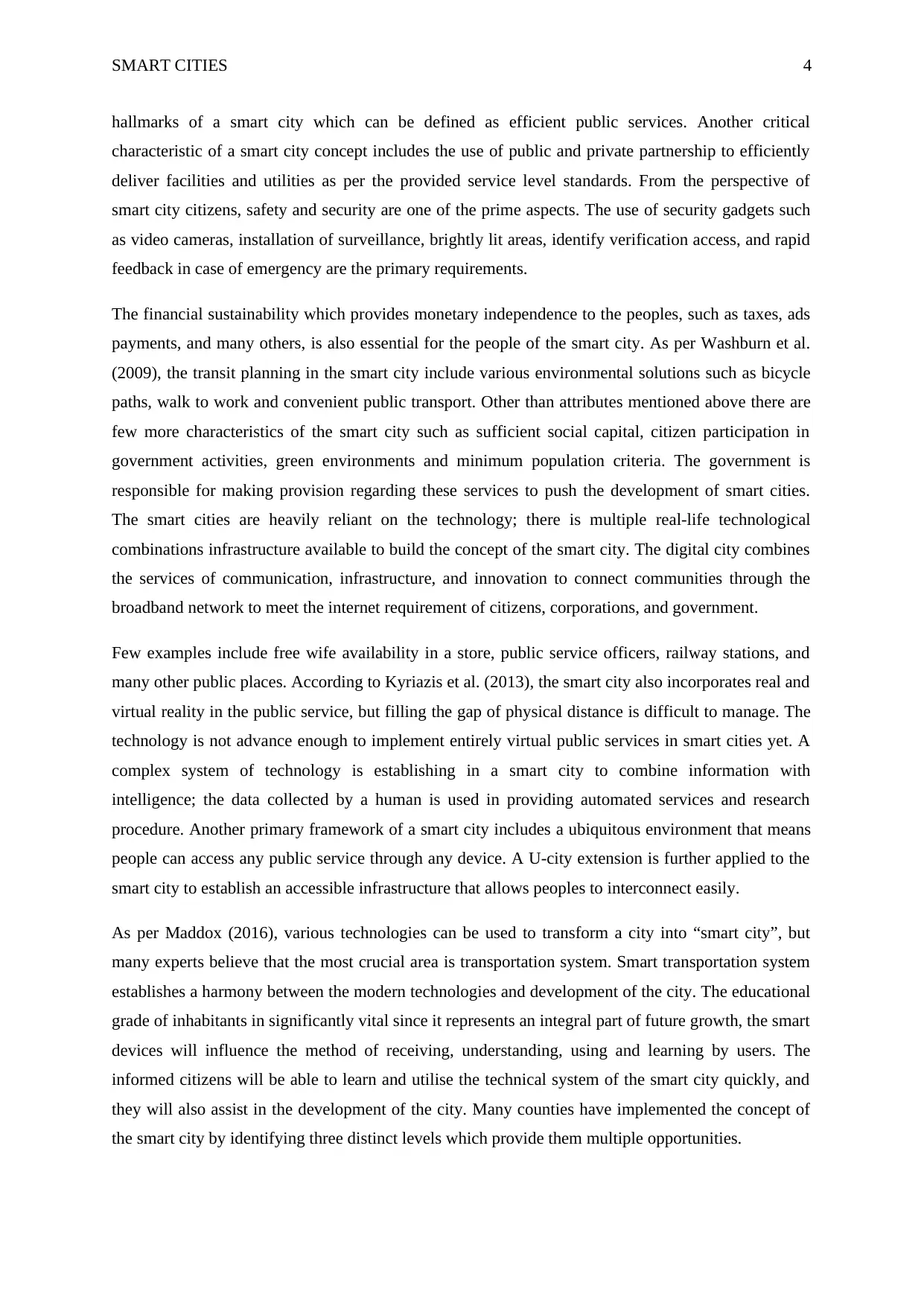
SMART CITIES 4
hallmarks of a smart city which can be defined as efficient public services. Another critical
characteristic of a smart city concept includes the use of public and private partnership to efficiently
deliver facilities and utilities as per the provided service level standards. From the perspective of
smart city citizens, safety and security are one of the prime aspects. The use of security gadgets such
as video cameras, installation of surveillance, brightly lit areas, identify verification access, and rapid
feedback in case of emergency are the primary requirements.
The financial sustainability which provides monetary independence to the peoples, such as taxes, ads
payments, and many others, is also essential for the people of the smart city. As per Washburn et al.
(2009), the transit planning in the smart city include various environmental solutions such as bicycle
paths, walk to work and convenient public transport. Other than attributes mentioned above there are
few more characteristics of the smart city such as sufficient social capital, citizen participation in
government activities, green environments and minimum population criteria. The government is
responsible for making provision regarding these services to push the development of smart cities.
The smart cities are heavily reliant on the technology; there is multiple real-life technological
combinations infrastructure available to build the concept of the smart city. The digital city combines
the services of communication, infrastructure, and innovation to connect communities through the
broadband network to meet the internet requirement of citizens, corporations, and government.
Few examples include free wife availability in a store, public service officers, railway stations, and
many other public places. According to Kyriazis et al. (2013), the smart city also incorporates real and
virtual reality in the public service, but filling the gap of physical distance is difficult to manage. The
technology is not advance enough to implement entirely virtual public services in smart cities yet. A
complex system of technology is establishing in a smart city to combine information with
intelligence; the data collected by a human is used in providing automated services and research
procedure. Another primary framework of a smart city includes a ubiquitous environment that means
people can access any public service through any device. A U-city extension is further applied to the
smart city to establish an accessible infrastructure that allows peoples to interconnect easily.
As per Maddox (2016), various technologies can be used to transform a city into “smart city”, but
many experts believe that the most crucial area is transportation system. Smart transportation system
establishes a harmony between the modern technologies and development of the city. The educational
grade of inhabitants in significantly vital since it represents an integral part of future growth, the smart
devices will influence the method of receiving, understanding, using and learning by users. The
informed citizens will be able to learn and utilise the technical system of the smart city quickly, and
they will also assist in the development of the city. Many counties have implemented the concept of
the smart city by identifying three distinct levels which provide them multiple opportunities.
hallmarks of a smart city which can be defined as efficient public services. Another critical
characteristic of a smart city concept includes the use of public and private partnership to efficiently
deliver facilities and utilities as per the provided service level standards. From the perspective of
smart city citizens, safety and security are one of the prime aspects. The use of security gadgets such
as video cameras, installation of surveillance, brightly lit areas, identify verification access, and rapid
feedback in case of emergency are the primary requirements.
The financial sustainability which provides monetary independence to the peoples, such as taxes, ads
payments, and many others, is also essential for the people of the smart city. As per Washburn et al.
(2009), the transit planning in the smart city include various environmental solutions such as bicycle
paths, walk to work and convenient public transport. Other than attributes mentioned above there are
few more characteristics of the smart city such as sufficient social capital, citizen participation in
government activities, green environments and minimum population criteria. The government is
responsible for making provision regarding these services to push the development of smart cities.
The smart cities are heavily reliant on the technology; there is multiple real-life technological
combinations infrastructure available to build the concept of the smart city. The digital city combines
the services of communication, infrastructure, and innovation to connect communities through the
broadband network to meet the internet requirement of citizens, corporations, and government.
Few examples include free wife availability in a store, public service officers, railway stations, and
many other public places. According to Kyriazis et al. (2013), the smart city also incorporates real and
virtual reality in the public service, but filling the gap of physical distance is difficult to manage. The
technology is not advance enough to implement entirely virtual public services in smart cities yet. A
complex system of technology is establishing in a smart city to combine information with
intelligence; the data collected by a human is used in providing automated services and research
procedure. Another primary framework of a smart city includes a ubiquitous environment that means
people can access any public service through any device. A U-city extension is further applied to the
smart city to establish an accessible infrastructure that allows peoples to interconnect easily.
As per Maddox (2016), various technologies can be used to transform a city into “smart city”, but
many experts believe that the most crucial area is transportation system. Smart transportation system
establishes a harmony between the modern technologies and development of the city. The educational
grade of inhabitants in significantly vital since it represents an integral part of future growth, the smart
devices will influence the method of receiving, understanding, using and learning by users. The
informed citizens will be able to learn and utilise the technical system of the smart city quickly, and
they will also assist in the development of the city. Many counties have implemented the concept of
the smart city by identifying three distinct levels which provide them multiple opportunities.
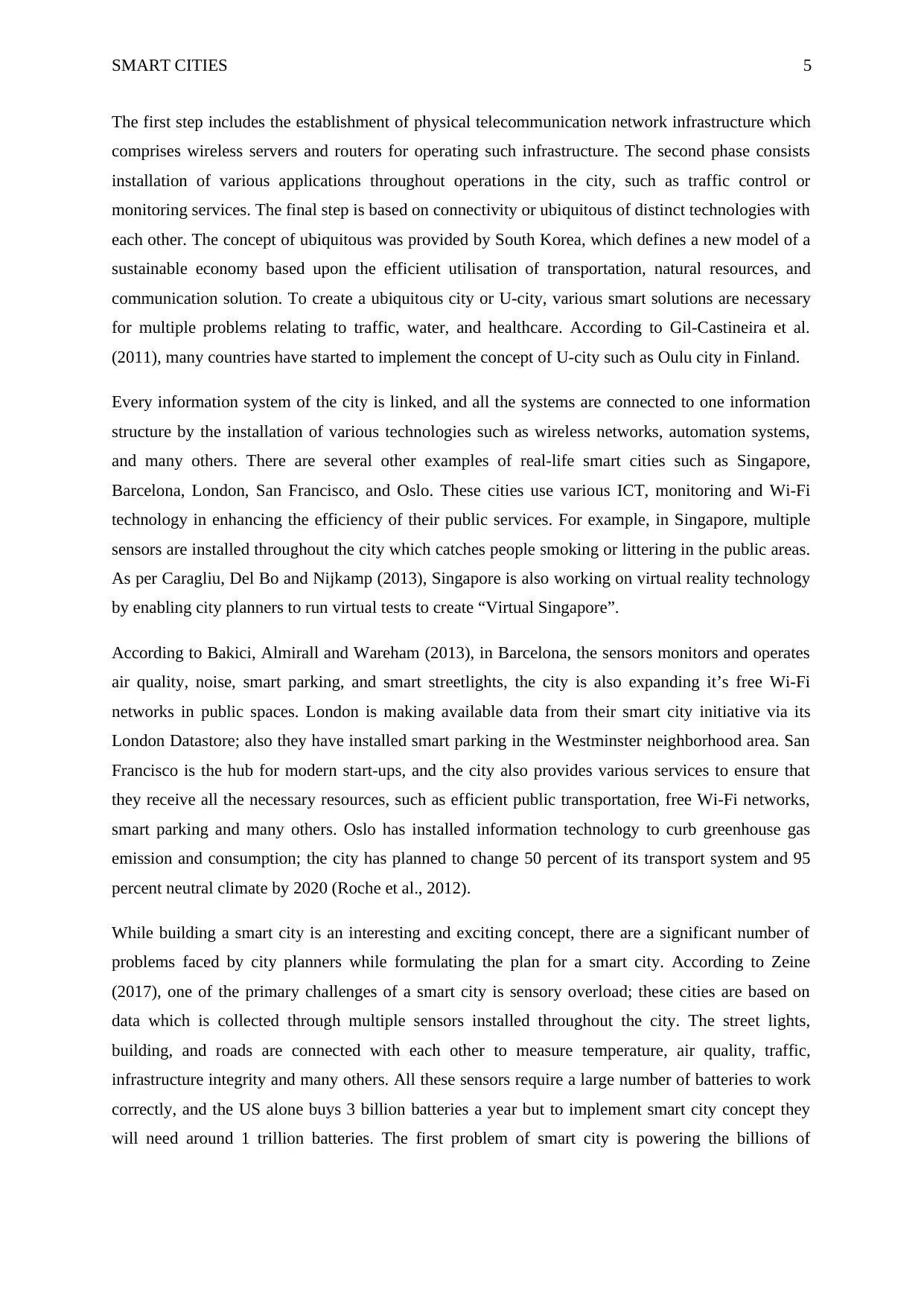
SMART CITIES 5
The first step includes the establishment of physical telecommunication network infrastructure which
comprises wireless servers and routers for operating such infrastructure. The second phase consists
installation of various applications throughout operations in the city, such as traffic control or
monitoring services. The final step is based on connectivity or ubiquitous of distinct technologies with
each other. The concept of ubiquitous was provided by South Korea, which defines a new model of a
sustainable economy based upon the efficient utilisation of transportation, natural resources, and
communication solution. To create a ubiquitous city or U-city, various smart solutions are necessary
for multiple problems relating to traffic, water, and healthcare. According to Gil-Castineira et al.
(2011), many countries have started to implement the concept of U-city such as Oulu city in Finland.
Every information system of the city is linked, and all the systems are connected to one information
structure by the installation of various technologies such as wireless networks, automation systems,
and many others. There are several other examples of real-life smart cities such as Singapore,
Barcelona, London, San Francisco, and Oslo. These cities use various ICT, monitoring and Wi-Fi
technology in enhancing the efficiency of their public services. For example, in Singapore, multiple
sensors are installed throughout the city which catches people smoking or littering in the public areas.
As per Caragliu, Del Bo and Nijkamp (2013), Singapore is also working on virtual reality technology
by enabling city planners to run virtual tests to create “Virtual Singapore”.
According to Bakici, Almirall and Wareham (2013), in Barcelona, the sensors monitors and operates
air quality, noise, smart parking, and smart streetlights, the city is also expanding it’s free Wi-Fi
networks in public spaces. London is making available data from their smart city initiative via its
London Datastore; also they have installed smart parking in the Westminster neighborhood area. San
Francisco is the hub for modern start-ups, and the city also provides various services to ensure that
they receive all the necessary resources, such as efficient public transportation, free Wi-Fi networks,
smart parking and many others. Oslo has installed information technology to curb greenhouse gas
emission and consumption; the city has planned to change 50 percent of its transport system and 95
percent neutral climate by 2020 (Roche et al., 2012).
While building a smart city is an interesting and exciting concept, there are a significant number of
problems faced by city planners while formulating the plan for a smart city. According to Zeine
(2017), one of the primary challenges of a smart city is sensory overload; these cities are based on
data which is collected through multiple sensors installed throughout the city. The street lights,
building, and roads are connected with each other to measure temperature, air quality, traffic,
infrastructure integrity and many others. All these sensors require a large number of batteries to work
correctly, and the US alone buys 3 billion batteries a year but to implement smart city concept they
will need around 1 trillion batteries. The first problem of smart city is powering the billions of
The first step includes the establishment of physical telecommunication network infrastructure which
comprises wireless servers and routers for operating such infrastructure. The second phase consists
installation of various applications throughout operations in the city, such as traffic control or
monitoring services. The final step is based on connectivity or ubiquitous of distinct technologies with
each other. The concept of ubiquitous was provided by South Korea, which defines a new model of a
sustainable economy based upon the efficient utilisation of transportation, natural resources, and
communication solution. To create a ubiquitous city or U-city, various smart solutions are necessary
for multiple problems relating to traffic, water, and healthcare. According to Gil-Castineira et al.
(2011), many countries have started to implement the concept of U-city such as Oulu city in Finland.
Every information system of the city is linked, and all the systems are connected to one information
structure by the installation of various technologies such as wireless networks, automation systems,
and many others. There are several other examples of real-life smart cities such as Singapore,
Barcelona, London, San Francisco, and Oslo. These cities use various ICT, monitoring and Wi-Fi
technology in enhancing the efficiency of their public services. For example, in Singapore, multiple
sensors are installed throughout the city which catches people smoking or littering in the public areas.
As per Caragliu, Del Bo and Nijkamp (2013), Singapore is also working on virtual reality technology
by enabling city planners to run virtual tests to create “Virtual Singapore”.
According to Bakici, Almirall and Wareham (2013), in Barcelona, the sensors monitors and operates
air quality, noise, smart parking, and smart streetlights, the city is also expanding it’s free Wi-Fi
networks in public spaces. London is making available data from their smart city initiative via its
London Datastore; also they have installed smart parking in the Westminster neighborhood area. San
Francisco is the hub for modern start-ups, and the city also provides various services to ensure that
they receive all the necessary resources, such as efficient public transportation, free Wi-Fi networks,
smart parking and many others. Oslo has installed information technology to curb greenhouse gas
emission and consumption; the city has planned to change 50 percent of its transport system and 95
percent neutral climate by 2020 (Roche et al., 2012).
While building a smart city is an interesting and exciting concept, there are a significant number of
problems faced by city planners while formulating the plan for a smart city. According to Zeine
(2017), one of the primary challenges of a smart city is sensory overload; these cities are based on
data which is collected through multiple sensors installed throughout the city. The street lights,
building, and roads are connected with each other to measure temperature, air quality, traffic,
infrastructure integrity and many others. All these sensors require a large number of batteries to work
correctly, and the US alone buys 3 billion batteries a year but to implement smart city concept they
will need around 1 trillion batteries. The first problem of smart city is powering the billions of
⊘ This is a preview!⊘
Do you want full access?
Subscribe today to unlock all pages.

Trusted by 1+ million students worldwide
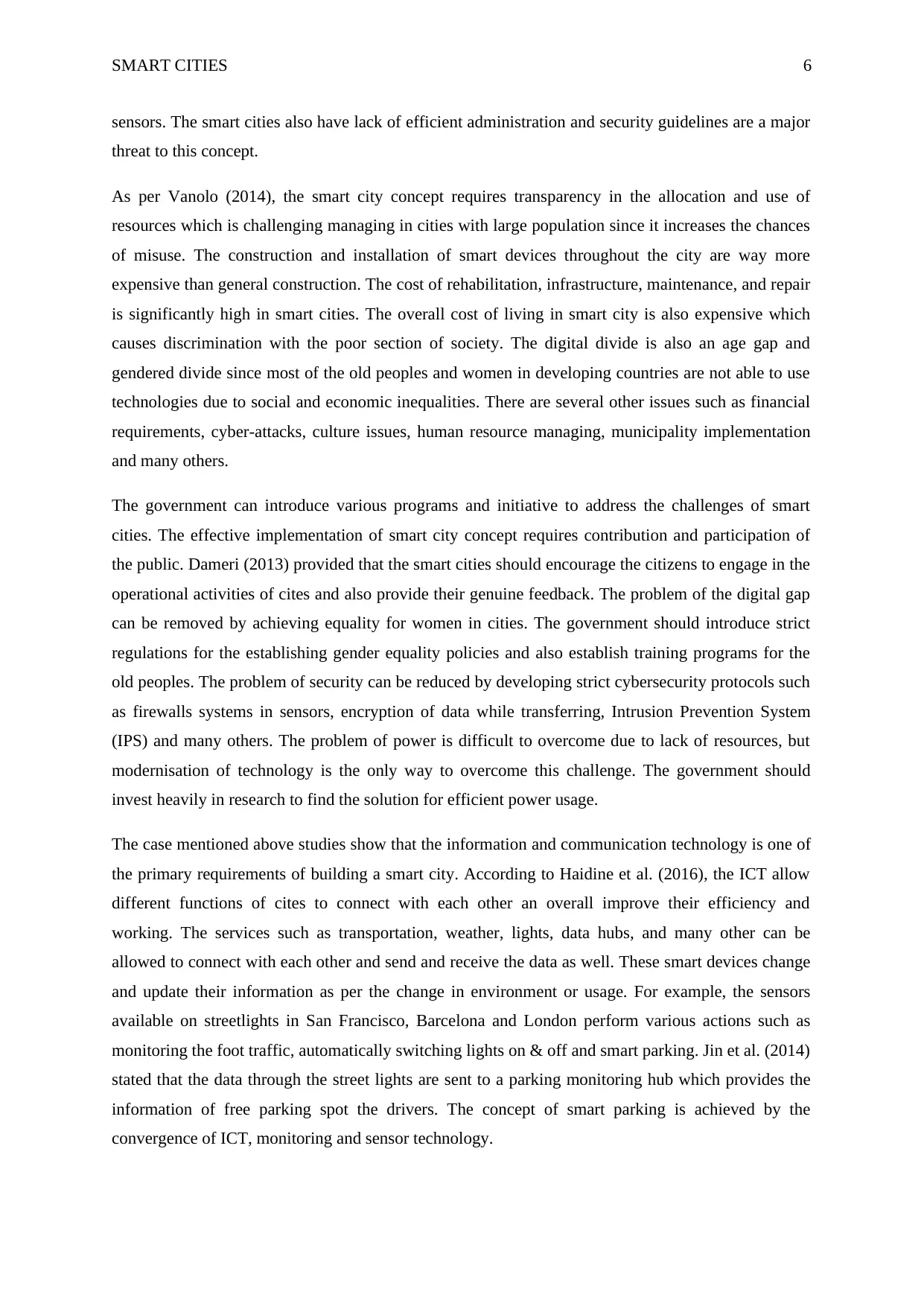
SMART CITIES 6
sensors. The smart cities also have lack of efficient administration and security guidelines are a major
threat to this concept.
As per Vanolo (2014), the smart city concept requires transparency in the allocation and use of
resources which is challenging managing in cities with large population since it increases the chances
of misuse. The construction and installation of smart devices throughout the city are way more
expensive than general construction. The cost of rehabilitation, infrastructure, maintenance, and repair
is significantly high in smart cities. The overall cost of living in smart city is also expensive which
causes discrimination with the poor section of society. The digital divide is also an age gap and
gendered divide since most of the old peoples and women in developing countries are not able to use
technologies due to social and economic inequalities. There are several other issues such as financial
requirements, cyber-attacks, culture issues, human resource managing, municipality implementation
and many others.
The government can introduce various programs and initiative to address the challenges of smart
cities. The effective implementation of smart city concept requires contribution and participation of
the public. Dameri (2013) provided that the smart cities should encourage the citizens to engage in the
operational activities of cites and also provide their genuine feedback. The problem of the digital gap
can be removed by achieving equality for women in cities. The government should introduce strict
regulations for the establishing gender equality policies and also establish training programs for the
old peoples. The problem of security can be reduced by developing strict cybersecurity protocols such
as firewalls systems in sensors, encryption of data while transferring, Intrusion Prevention System
(IPS) and many others. The problem of power is difficult to overcome due to lack of resources, but
modernisation of technology is the only way to overcome this challenge. The government should
invest heavily in research to find the solution for efficient power usage.
The case mentioned above studies show that the information and communication technology is one of
the primary requirements of building a smart city. According to Haidine et al. (2016), the ICT allow
different functions of cites to connect with each other an overall improve their efficiency and
working. The services such as transportation, weather, lights, data hubs, and many other can be
allowed to connect with each other and send and receive the data as well. These smart devices change
and update their information as per the change in environment or usage. For example, the sensors
available on streetlights in San Francisco, Barcelona and London perform various actions such as
monitoring the foot traffic, automatically switching lights on & off and smart parking. Jin et al. (2014)
stated that the data through the street lights are sent to a parking monitoring hub which provides the
information of free parking spot the drivers. The concept of smart parking is achieved by the
convergence of ICT, monitoring and sensor technology.
sensors. The smart cities also have lack of efficient administration and security guidelines are a major
threat to this concept.
As per Vanolo (2014), the smart city concept requires transparency in the allocation and use of
resources which is challenging managing in cities with large population since it increases the chances
of misuse. The construction and installation of smart devices throughout the city are way more
expensive than general construction. The cost of rehabilitation, infrastructure, maintenance, and repair
is significantly high in smart cities. The overall cost of living in smart city is also expensive which
causes discrimination with the poor section of society. The digital divide is also an age gap and
gendered divide since most of the old peoples and women in developing countries are not able to use
technologies due to social and economic inequalities. There are several other issues such as financial
requirements, cyber-attacks, culture issues, human resource managing, municipality implementation
and many others.
The government can introduce various programs and initiative to address the challenges of smart
cities. The effective implementation of smart city concept requires contribution and participation of
the public. Dameri (2013) provided that the smart cities should encourage the citizens to engage in the
operational activities of cites and also provide their genuine feedback. The problem of the digital gap
can be removed by achieving equality for women in cities. The government should introduce strict
regulations for the establishing gender equality policies and also establish training programs for the
old peoples. The problem of security can be reduced by developing strict cybersecurity protocols such
as firewalls systems in sensors, encryption of data while transferring, Intrusion Prevention System
(IPS) and many others. The problem of power is difficult to overcome due to lack of resources, but
modernisation of technology is the only way to overcome this challenge. The government should
invest heavily in research to find the solution for efficient power usage.
The case mentioned above studies show that the information and communication technology is one of
the primary requirements of building a smart city. According to Haidine et al. (2016), the ICT allow
different functions of cites to connect with each other an overall improve their efficiency and
working. The services such as transportation, weather, lights, data hubs, and many other can be
allowed to connect with each other and send and receive the data as well. These smart devices change
and update their information as per the change in environment or usage. For example, the sensors
available on streetlights in San Francisco, Barcelona and London perform various actions such as
monitoring the foot traffic, automatically switching lights on & off and smart parking. Jin et al. (2014)
stated that the data through the street lights are sent to a parking monitoring hub which provides the
information of free parking spot the drivers. The concept of smart parking is achieved by the
convergence of ICT, monitoring and sensor technology.
Paraphrase This Document
Need a fresh take? Get an instant paraphrase of this document with our AI Paraphraser
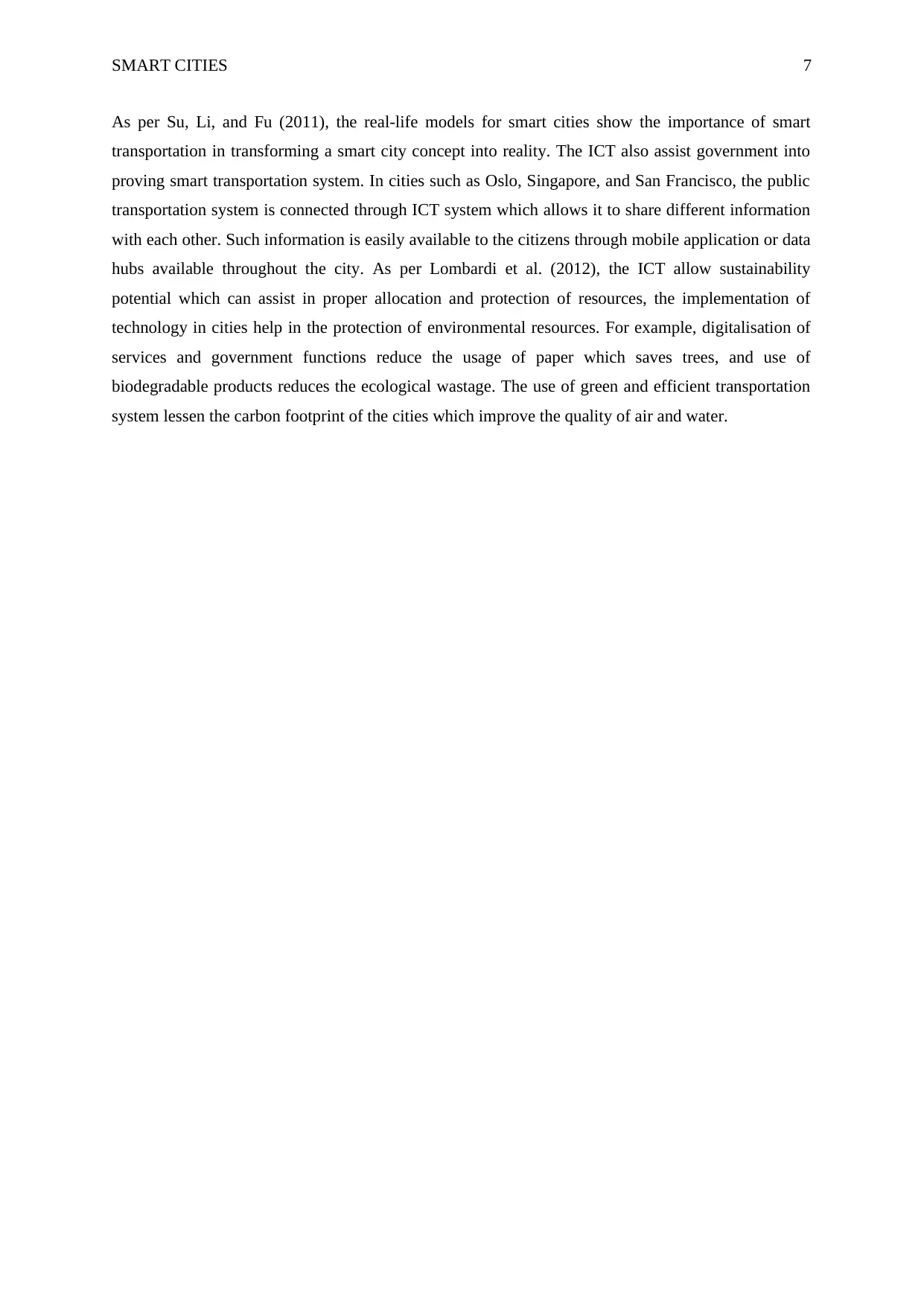
SMART CITIES 7
As per Su, Li, and Fu (2011), the real-life models for smart cities show the importance of smart
transportation in transforming a smart city concept into reality. The ICT also assist government into
proving smart transportation system. In cities such as Oslo, Singapore, and San Francisco, the public
transportation system is connected through ICT system which allows it to share different information
with each other. Such information is easily available to the citizens through mobile application or data
hubs available throughout the city. As per Lombardi et al. (2012), the ICT allow sustainability
potential which can assist in proper allocation and protection of resources, the implementation of
technology in cities help in the protection of environmental resources. For example, digitalisation of
services and government functions reduce the usage of paper which saves trees, and use of
biodegradable products reduces the ecological wastage. The use of green and efficient transportation
system lessen the carbon footprint of the cities which improve the quality of air and water.
As per Su, Li, and Fu (2011), the real-life models for smart cities show the importance of smart
transportation in transforming a smart city concept into reality. The ICT also assist government into
proving smart transportation system. In cities such as Oslo, Singapore, and San Francisco, the public
transportation system is connected through ICT system which allows it to share different information
with each other. Such information is easily available to the citizens through mobile application or data
hubs available throughout the city. As per Lombardi et al. (2012), the ICT allow sustainability
potential which can assist in proper allocation and protection of resources, the implementation of
technology in cities help in the protection of environmental resources. For example, digitalisation of
services and government functions reduce the usage of paper which saves trees, and use of
biodegradable products reduces the ecological wastage. The use of green and efficient transportation
system lessen the carbon footprint of the cities which improve the quality of air and water.
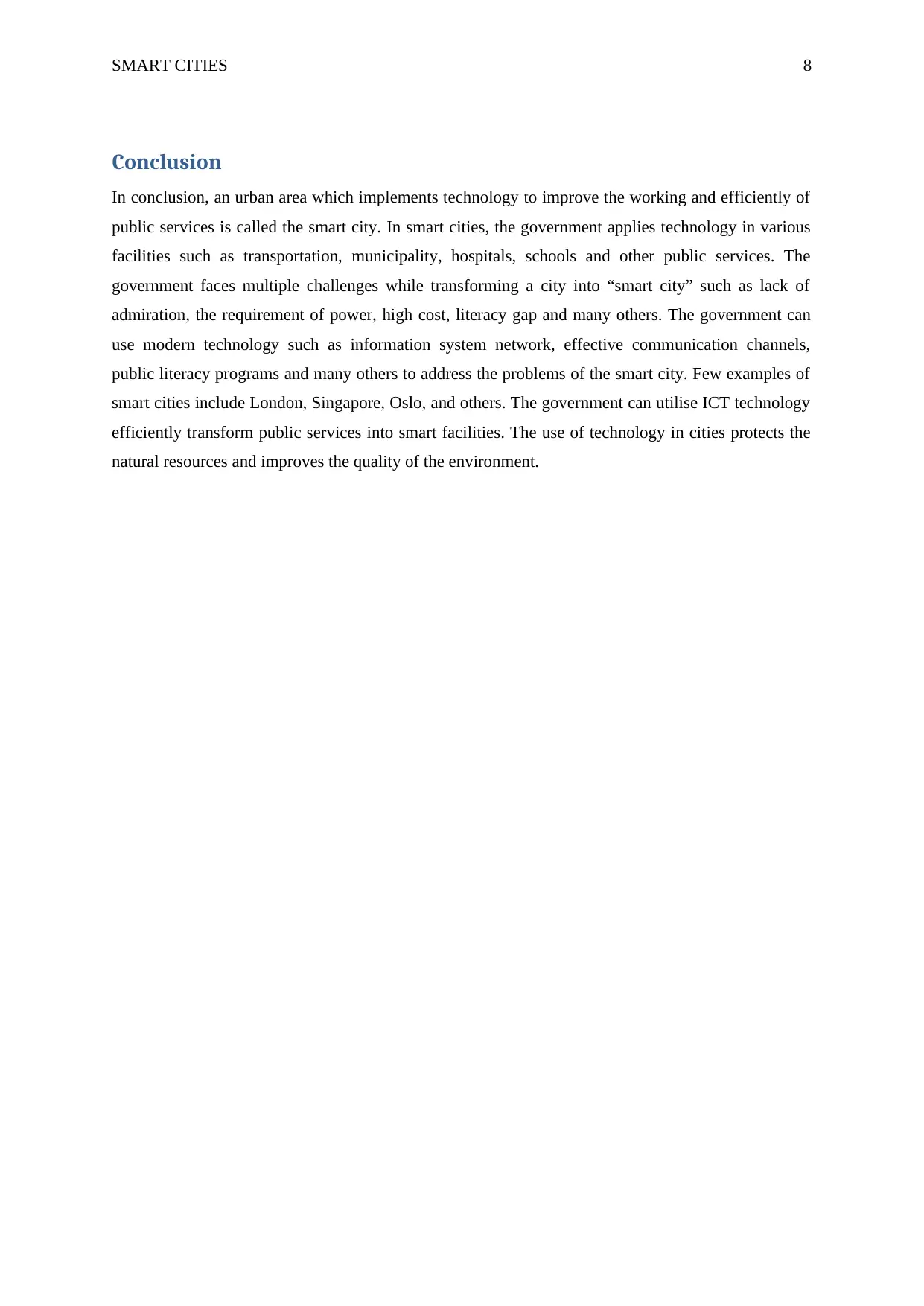
SMART CITIES 8
Conclusion
In conclusion, an urban area which implements technology to improve the working and efficiently of
public services is called the smart city. In smart cities, the government applies technology in various
facilities such as transportation, municipality, hospitals, schools and other public services. The
government faces multiple challenges while transforming a city into “smart city” such as lack of
admiration, the requirement of power, high cost, literacy gap and many others. The government can
use modern technology such as information system network, effective communication channels,
public literacy programs and many others to address the problems of the smart city. Few examples of
smart cities include London, Singapore, Oslo, and others. The government can utilise ICT technology
efficiently transform public services into smart facilities. The use of technology in cities protects the
natural resources and improves the quality of the environment.
Conclusion
In conclusion, an urban area which implements technology to improve the working and efficiently of
public services is called the smart city. In smart cities, the government applies technology in various
facilities such as transportation, municipality, hospitals, schools and other public services. The
government faces multiple challenges while transforming a city into “smart city” such as lack of
admiration, the requirement of power, high cost, literacy gap and many others. The government can
use modern technology such as information system network, effective communication channels,
public literacy programs and many others to address the problems of the smart city. Few examples of
smart cities include London, Singapore, Oslo, and others. The government can utilise ICT technology
efficiently transform public services into smart facilities. The use of technology in cities protects the
natural resources and improves the quality of the environment.
⊘ This is a preview!⊘
Do you want full access?
Subscribe today to unlock all pages.

Trusted by 1+ million students worldwide
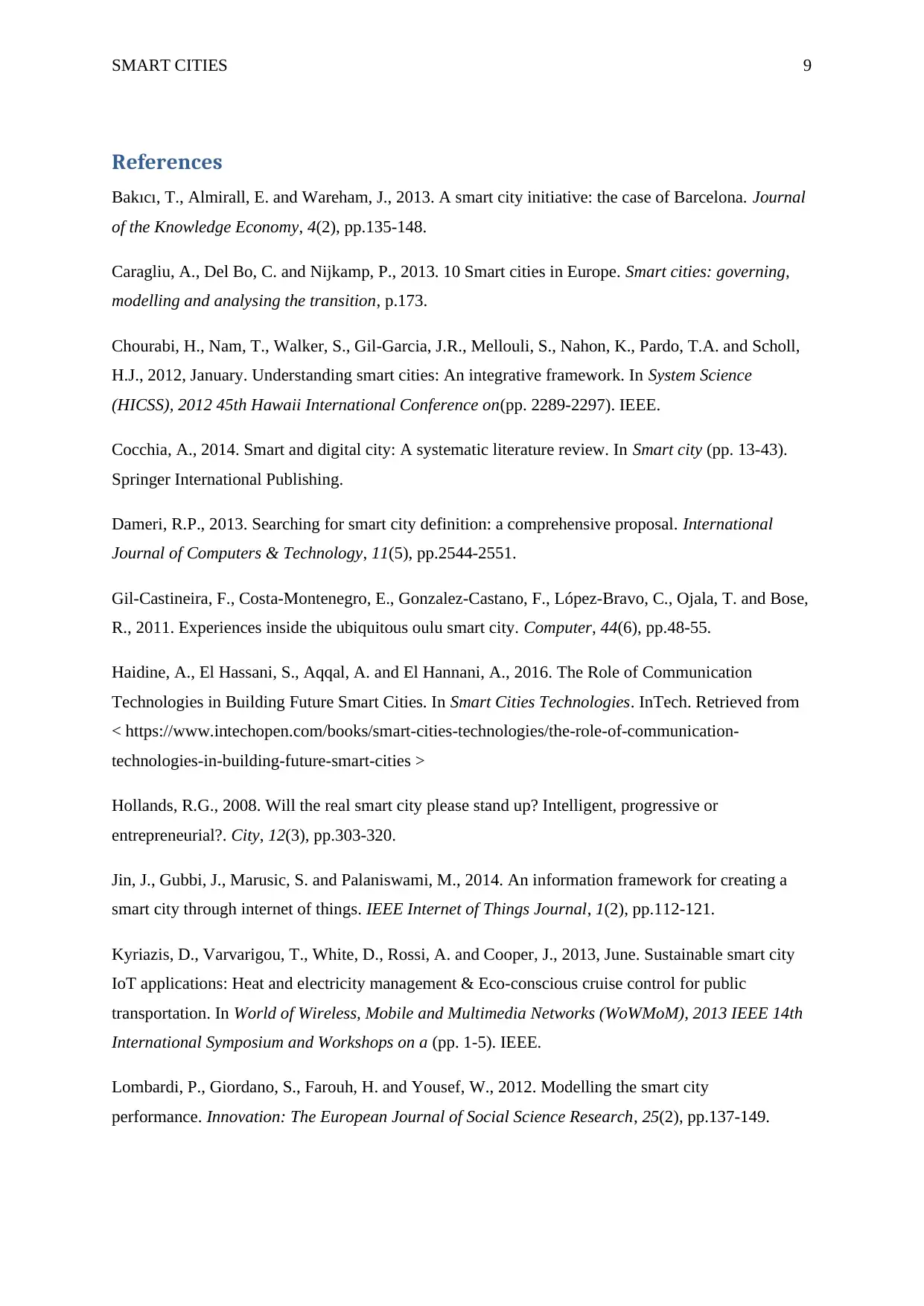
SMART CITIES 9
References
Bakıcı, T., Almirall, E. and Wareham, J., 2013. A smart city initiative: the case of Barcelona. Journal
of the Knowledge Economy, 4(2), pp.135-148.
Caragliu, A., Del Bo, C. and Nijkamp, P., 2013. 10 Smart cities in Europe. Smart cities: governing,
modelling and analysing the transition, p.173.
Chourabi, H., Nam, T., Walker, S., Gil-Garcia, J.R., Mellouli, S., Nahon, K., Pardo, T.A. and Scholl,
H.J., 2012, January. Understanding smart cities: An integrative framework. In System Science
(HICSS), 2012 45th Hawaii International Conference on(pp. 2289-2297). IEEE.
Cocchia, A., 2014. Smart and digital city: A systematic literature review. In Smart city (pp. 13-43).
Springer International Publishing.
Dameri, R.P., 2013. Searching for smart city definition: a comprehensive proposal. International
Journal of Computers & Technology, 11(5), pp.2544-2551.
Gil-Castineira, F., Costa-Montenegro, E., Gonzalez-Castano, F., López-Bravo, C., Ojala, T. and Bose,
R., 2011. Experiences inside the ubiquitous oulu smart city. Computer, 44(6), pp.48-55.
Haidine, A., El Hassani, S., Aqqal, A. and El Hannani, A., 2016. The Role of Communication
Technologies in Building Future Smart Cities. In Smart Cities Technologies. InTech. Retrieved from
< https://www.intechopen.com/books/smart-cities-technologies/the-role-of-communication-
technologies-in-building-future-smart-cities >
Hollands, R.G., 2008. Will the real smart city please stand up? Intelligent, progressive or
entrepreneurial?. City, 12(3), pp.303-320.
Jin, J., Gubbi, J., Marusic, S. and Palaniswami, M., 2014. An information framework for creating a
smart city through internet of things. IEEE Internet of Things Journal, 1(2), pp.112-121.
Kyriazis, D., Varvarigou, T., White, D., Rossi, A. and Cooper, J., 2013, June. Sustainable smart city
IoT applications: Heat and electricity management & Eco-conscious cruise control for public
transportation. In World of Wireless, Mobile and Multimedia Networks (WoWMoM), 2013 IEEE 14th
International Symposium and Workshops on a (pp. 1-5). IEEE.
Lombardi, P., Giordano, S., Farouh, H. and Yousef, W., 2012. Modelling the smart city
performance. Innovation: The European Journal of Social Science Research, 25(2), pp.137-149.
References
Bakıcı, T., Almirall, E. and Wareham, J., 2013. A smart city initiative: the case of Barcelona. Journal
of the Knowledge Economy, 4(2), pp.135-148.
Caragliu, A., Del Bo, C. and Nijkamp, P., 2013. 10 Smart cities in Europe. Smart cities: governing,
modelling and analysing the transition, p.173.
Chourabi, H., Nam, T., Walker, S., Gil-Garcia, J.R., Mellouli, S., Nahon, K., Pardo, T.A. and Scholl,
H.J., 2012, January. Understanding smart cities: An integrative framework. In System Science
(HICSS), 2012 45th Hawaii International Conference on(pp. 2289-2297). IEEE.
Cocchia, A., 2014. Smart and digital city: A systematic literature review. In Smart city (pp. 13-43).
Springer International Publishing.
Dameri, R.P., 2013. Searching for smart city definition: a comprehensive proposal. International
Journal of Computers & Technology, 11(5), pp.2544-2551.
Gil-Castineira, F., Costa-Montenegro, E., Gonzalez-Castano, F., López-Bravo, C., Ojala, T. and Bose,
R., 2011. Experiences inside the ubiquitous oulu smart city. Computer, 44(6), pp.48-55.
Haidine, A., El Hassani, S., Aqqal, A. and El Hannani, A., 2016. The Role of Communication
Technologies in Building Future Smart Cities. In Smart Cities Technologies. InTech. Retrieved from
< https://www.intechopen.com/books/smart-cities-technologies/the-role-of-communication-
technologies-in-building-future-smart-cities >
Hollands, R.G., 2008. Will the real smart city please stand up? Intelligent, progressive or
entrepreneurial?. City, 12(3), pp.303-320.
Jin, J., Gubbi, J., Marusic, S. and Palaniswami, M., 2014. An information framework for creating a
smart city through internet of things. IEEE Internet of Things Journal, 1(2), pp.112-121.
Kyriazis, D., Varvarigou, T., White, D., Rossi, A. and Cooper, J., 2013, June. Sustainable smart city
IoT applications: Heat and electricity management & Eco-conscious cruise control for public
transportation. In World of Wireless, Mobile and Multimedia Networks (WoWMoM), 2013 IEEE 14th
International Symposium and Workshops on a (pp. 1-5). IEEE.
Lombardi, P., Giordano, S., Farouh, H. and Yousef, W., 2012. Modelling the smart city
performance. Innovation: The European Journal of Social Science Research, 25(2), pp.137-149.
Paraphrase This Document
Need a fresh take? Get an instant paraphrase of this document with our AI Paraphraser
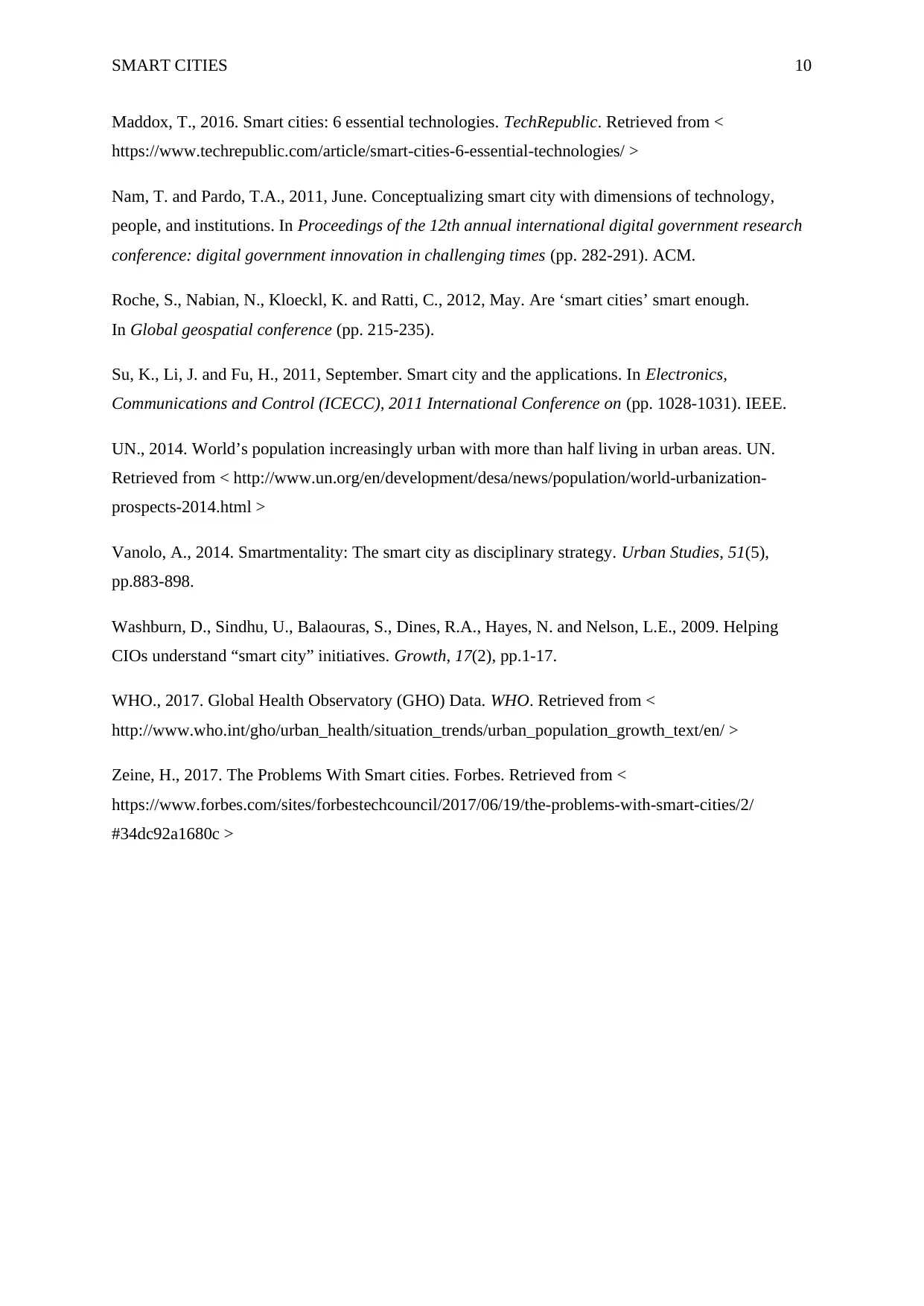
SMART CITIES 10
Maddox, T., 2016. Smart cities: 6 essential technologies. TechRepublic. Retrieved from <
https://www.techrepublic.com/article/smart-cities-6-essential-technologies/ >
Nam, T. and Pardo, T.A., 2011, June. Conceptualizing smart city with dimensions of technology,
people, and institutions. In Proceedings of the 12th annual international digital government research
conference: digital government innovation in challenging times (pp. 282-291). ACM.
Roche, S., Nabian, N., Kloeckl, K. and Ratti, C., 2012, May. Are ‘smart cities’ smart enough.
In Global geospatial conference (pp. 215-235).
Su, K., Li, J. and Fu, H., 2011, September. Smart city and the applications. In Electronics,
Communications and Control (ICECC), 2011 International Conference on (pp. 1028-1031). IEEE.
UN., 2014. World’s population increasingly urban with more than half living in urban areas. UN.
Retrieved from < http://www.un.org/en/development/desa/news/population/world-urbanization-
prospects-2014.html >
Vanolo, A., 2014. Smartmentality: The smart city as disciplinary strategy. Urban Studies, 51(5),
pp.883-898.
Washburn, D., Sindhu, U., Balaouras, S., Dines, R.A., Hayes, N. and Nelson, L.E., 2009. Helping
CIOs understand “smart city” initiatives. Growth, 17(2), pp.1-17.
WHO., 2017. Global Health Observatory (GHO) Data. WHO. Retrieved from <
http://www.who.int/gho/urban_health/situation_trends/urban_population_growth_text/en/ >
Zeine, H., 2017. The Problems With Smart cities. Forbes. Retrieved from <
https://www.forbes.com/sites/forbestechcouncil/2017/06/19/the-problems-with-smart-cities/2/
#34dc92a1680c >
Maddox, T., 2016. Smart cities: 6 essential technologies. TechRepublic. Retrieved from <
https://www.techrepublic.com/article/smart-cities-6-essential-technologies/ >
Nam, T. and Pardo, T.A., 2011, June. Conceptualizing smart city with dimensions of technology,
people, and institutions. In Proceedings of the 12th annual international digital government research
conference: digital government innovation in challenging times (pp. 282-291). ACM.
Roche, S., Nabian, N., Kloeckl, K. and Ratti, C., 2012, May. Are ‘smart cities’ smart enough.
In Global geospatial conference (pp. 215-235).
Su, K., Li, J. and Fu, H., 2011, September. Smart city and the applications. In Electronics,
Communications and Control (ICECC), 2011 International Conference on (pp. 1028-1031). IEEE.
UN., 2014. World’s population increasingly urban with more than half living in urban areas. UN.
Retrieved from < http://www.un.org/en/development/desa/news/population/world-urbanization-
prospects-2014.html >
Vanolo, A., 2014. Smartmentality: The smart city as disciplinary strategy. Urban Studies, 51(5),
pp.883-898.
Washburn, D., Sindhu, U., Balaouras, S., Dines, R.A., Hayes, N. and Nelson, L.E., 2009. Helping
CIOs understand “smart city” initiatives. Growth, 17(2), pp.1-17.
WHO., 2017. Global Health Observatory (GHO) Data. WHO. Retrieved from <
http://www.who.int/gho/urban_health/situation_trends/urban_population_growth_text/en/ >
Zeine, H., 2017. The Problems With Smart cities. Forbes. Retrieved from <
https://www.forbes.com/sites/forbestechcouncil/2017/06/19/the-problems-with-smart-cities/2/
#34dc92a1680c >
1 out of 11
Related Documents
Your All-in-One AI-Powered Toolkit for Academic Success.
+13062052269
info@desklib.com
Available 24*7 on WhatsApp / Email
![[object Object]](/_next/static/media/star-bottom.7253800d.svg)
Unlock your academic potential
Copyright © 2020–2025 A2Z Services. All Rights Reserved. Developed and managed by ZUCOL.




